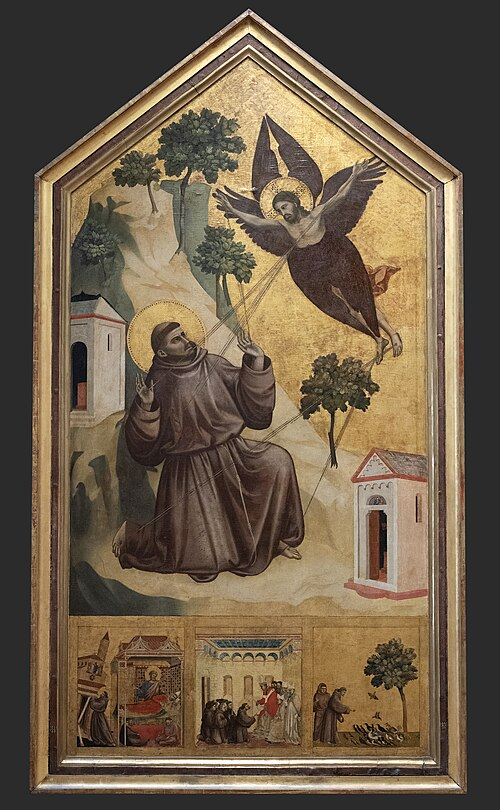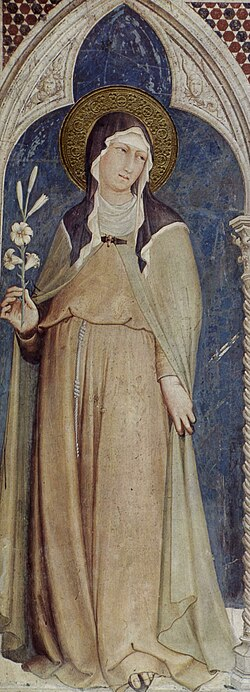OCR Specification focus:
‘St Francis, poverty and the founding of the Franciscans and Poor Clares, the split between Spirituals (Joachim of Fiore) and Conventionals.’
The Mendicant Orders marked a revolutionary shift in medieval religious life, led by charismatic figures whose leadership reshaped attitudes to poverty, preaching, and Church authority.
St Francis of Assisi: Founder of the Franciscans
St Francis of Assisi (1181/2–1226) was a key religious leader whose emphasis on poverty and humility inspired the creation of the Franciscan Order. Born into a wealthy merchant family in Assisi, Francis rejected material wealth and embraced a life of radical simplicity.

Giotto’s Saint Francis Receiving the Stigmata presents Francis as a model of imitatio Christi, the foundation of his authority and the Franciscans’ radical poverty. The scene at La Verna encapsulates the spiritual charisma that drew followers into an itinerant preaching life. This image supports the notes’ emphasis on leadership grounded in sanctity and visible witness. Source
Franciscan Order: A religious community founded by St Francis of Assisi, dedicated to poverty, itinerant preaching, and service to the poor.
Francis’ spiritual authority rested on his personal charisma and reputation for holiness. His followers, known as friars, sought to imitate Christ by living without property, depending on charity, and moving through towns to preach. Unlike traditional monastic orders, the Franciscans did not remain enclosed within monasteries, but instead worked actively among urban populations.
The Rule of St Francis
Francis wrote a Rule (set of guiding principles) for his order, which the Pope approved in 1223. It stressed:
Absolute poverty, both individually and collectively
Preaching and pastoral work in towns and villages
Humility, obedience, and simplicity of life
His approach contrasted sharply with wealthier monastic traditions such as the Benedictines and Cistercians, whose power often derived from landed estates.
The Poor Clares: A Female Expression of Franciscan Spirituality
The influence of Francis extended beyond men’s religious life. Clare of Assisi (1194–1253), inspired by Francis, founded the Order of Poor Ladies (later called the Poor Clares).
Poor Clares: A female Franciscan order founded by St Clare of Assisi, dedicated to poverty, enclosure, and prayer.

Simone Martini’s Santa Chiara d’Assisi presents Clare as a leader shaped by the Franciscan commitment to poverty and prayer. As founder of the Poor Clares, she defended strict poverty, complementing the male branch’s itinerant mission. This image directly supports the notes’ focus on female leadership within the Mendicant movement. Source
They differed, however, by being an enclosed order, spending their lives in monasteries rather than itinerant preaching. Clare herself resisted attempts by the Church to relax the strict poverty she had adopted, showing the powerful influence of Francis’ ideas on female religious life.
Leadership Tensions: The Spirituals and the Conventuals
The rapid growth of the Franciscan movement soon generated internal divisions. After Francis’ death, debates emerged over how strictly his rule of poverty should be interpreted.
The Spiritual Franciscans (Spirituals)
Insisted on absolute poverty with no possessions, even as a collective order.
Inspired by apocalyptic thought, particularly the writings of Joachim of Fiore, who prophesied a coming age of the Holy Spirit when true poverty would triumph.
Criticised the hierarchy of the Church and accused the Papacy of corruption.
The Conventual Franciscans (Conventuals)
Accepted a more moderate approach, allowing the order to hold property in common.
Worked within the structures of the Church, focusing on pastoral care, education, and service.
Aligned more closely with papal authority, ensuring the Franciscans remained an accepted part of medieval Christianity.
Joachim of Fiore: A 12th-century theologian and mystic who taught that history unfolded in three ages, culminating in a spiritual era marked by poverty and holiness.
The conflict between Spirituals and Conventuals reflected broader tensions in the Church between reforming zeal and institutional stability. Some Spiritual Franciscans were condemned as heretics, while the Conventuals became the mainstream form of the order.
Broader Leadership Impact of the Mendicant Orders
The leadership of Francis and Clare, along with debates within their communities, highlights the significance of the Mendicant Orders in medieval society. Their example influenced wider religious developments:
Urban Preaching: The friars’ mobility and visibility strengthened lay piety in towns.
Female Leadership: Clare demonstrated that women could play pivotal roles in shaping religious movements.
Church Authority: Tensions between Spirituals and Conventuals raised fundamental questions about obedience to papal authority versus fidelity to an ideal of poverty.
Inspiration for Others: The Franciscan model influenced the foundation of other mendicant movements, particularly the Dominicans, who also emphasised preaching and poverty.
Key Themes for Study
Poverty as a defining ideal: The Franciscans’ radical rejection of wealth challenged established religious norms.
Charismatic leadership: The movement’s success relied heavily on Francis’ personal sanctity and Clare’s determination.
Institutional conflict: Internal disputes revealed the tension between reformist ideals and the practical needs of a growing religious order.
Influence of apocalyptic prophecy: Joachim of Fiore’s ideas shaped the Spiritual Franciscans’ vision of Church renewal.
The Mendicant Orders therefore demonstrate how leadership and vision could transform medieval religious life, bringing new emphasis on poverty, urban engagement, and the role of women in spiritual communities.
FAQ
Earlier monastic orders such as the Benedictines and Cistercians maintained large landed estates and collective wealth, even if individuals took vows of poverty.
The Franciscans, under St Francis’ leadership, rejected not only personal wealth but also collective property. This radical approach meant they owned no land, buildings, or fixed income, relying entirely on charity and begging. Their itinerant lifestyle in towns and cities made them far more visible and connected to lay society.
Francis sought papal approval for his movement to secure legitimacy within the Church. Pope Honorius III approved the final Franciscan Rule in 1223.
This approval gave the Franciscans formal recognition, protecting them from accusations of heresy and ensuring they operated under papal oversight. At the same time, it created tensions, since papal authority often clashed with the Franciscan ideal of absolute poverty.
The central issue was how to interpret Francis’ demand for poverty.
Spirituals believed any relaxation betrayed Francis’ vision, aligning themselves with apocalyptic prophecy.
Conventuals argued that some material stability was necessary for pastoral and educational work.
The Church generally supported the Conventuals, while Spirituals were sometimes condemned as heretics.
Clare faced repeated efforts by popes to soften her order’s poverty requirement by allowing communal property.
She refused, insisting on the privilegium paupertatis (the privilege of poverty), which Pope Innocent IV granted in 1253. This formalised her community’s commitment to live without property or income, making the Poor Clares unique among female religious orders.
Joachim taught that history unfolded in three ages: the Age of the Father, the Son, and the Holy Spirit. The last would be a time of spiritual renewal.
The Spiritual Franciscans saw themselves as heralds of this new age, believing their strict poverty marked the fulfilment of Joachim’s prophecy. This apocalyptic outlook gave their cause urgency but also brought them into conflict with papal authority.
Practice Questions
Question 1 (2 marks):
Who founded the Franciscan Order and the Order of Poor Ladies (later called the Poor Clares)?
Mark Scheme:
1 mark for correctly identifying St Francis of Assisi as founder of the Franciscans.
1 mark for correctly identifying Clare of Assisi as founder of the Poor Clares.
Question 2 (6 marks):
Explain two ways in which the leadership of St Francis and Clare of Assisi shaped the development of the Mendicant Orders.
Mark Scheme:
Up to 3 marks for each explanation, with detail and accuracy required for full credit.
Award marks as follows:
Francis’ emphasis on poverty and itinerant preaching
1 mark for identifying Francis’ stress on absolute poverty.
1 mark for explaining how this distinguished the Franciscans from traditional monastic orders.
1 mark for showing how this approach attracted urban followers and influenced the order’s growth.
Clare’s leadership in founding the Poor Clares
1 mark for identifying Clare as founder of the female branch.
1 mark for explaining her commitment to enclosure and strict poverty.
1 mark for showing how her leadership extended Franciscan ideals to women, ensuring broader impact.
Alternative valid explanations (maximum of 3 marks each):
Francis’ personal charisma and holiness as a source of authority.
The example set by Clare in resisting attempts to relax poverty, reinforcing Franciscan ideals.
Either leader’s influence on later divisions between Spirituals and Conventuals.

